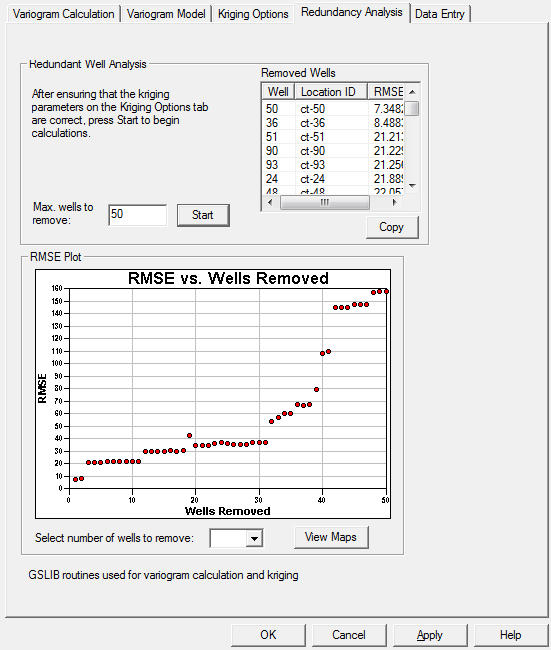
The well redundancy module in VSP is based on a geostatistical analysis of well locations. The algorithm is based on the accumulation of kriging weights to determine a global kriging weight associated with each well. The global kriging weight for a given data point is determined by adding the kriging weights for that data point for all locations in the kriging grid. Global kriging weights had previously been used by Isaaks and Srivastava (1989) as a method of providing global weights for individual data points. Cameron and Hunter (2002) used global kriging weights to identify the relative importance of wells in mapping contaminant plumes, and to identify wells that could be removed from the sampling schedule.
In VSP, wells are ranked in terms of their contribution to the plume map through the global kriging weight, and the lowest ranked data location is removed from the data set. The kriging and ranking process is then repeated until the maximum number of wells is removed from the data set. At each iterative step, the program calculates the root mean square error (RMSE) between the base plume map and the plume map generated after a given number of wells have been removed. The user then evaluates the number of wells that can reasonably be removed from the sampling schedule by examining the plot of RMSE versus the number of wells removed. In addition, maps showing the plume maps generated using the base case (all wells) can be compared with plume maps generated after eliminating a given number of wells.
The analysis is performed using a normal score transform of the data. Transformation of contamination data is often needed because of their tendency to be highly skewed (Gilbert 1987). The normal score is widely used in geostatistics because of its ability to transform data with any distribution into a variable with a perfectly normal (i.e., Gaussian) distribution (Deutsch and Journel 1998). The normal score transform is also used in the Probability and Uncertainty Mapping module in VSP.
The analyze tab allows a choice of the maximum number of wells to remove in the analysis. The default is all wells available for analysis. If the maximum to be removed is less than the total number of wells, which will almost always be the case, the total execution time will be reduced.
After choosing the maximum number of wells to be removed, start the analysis. If the execution appears to be extremely slow, e.g., a minute passes between each iteration that removes a well, hit the Stop button, and return to the Kriging tab to increase the size of the X and Y grid cell dimensions.
Once the iterative process is complete, and the wells have been ranked in order of their value, select View Maps to examine the base map and the map generated with a selected number of wells removed. There is no objective measure to determine how many wells can be removed. However, examination of the RMSE plot provides a measure of the increase in RMSE for removal of each well, and may suggest thresholds at which large increases in RMSE occur for selection of additional wells. That, coupled with comparison of maps for different numbers of removed wells, can be used to select the best number of wells to remove that will decrease sampling costs without adversely impacting the ability of maps based on the remaining data to adequately represent the plume.

Cameron, K, and P Hunter. 2002. Using Spatial Models and Kriging Techniques to Optimize Long-Term Ground-Water Monitoring Networks: A Case Study. Environmetrics 13:629-59.
Deutsch, C.V. and A.G. Journel. 1998. GSLIB Geostatistical Software Library and User's Guide, 2nd Edition, Applied Geostatistics Series, Oxford University Press, Inc. New York, NY.
Gilbert, RO. 1987. Statistical Methods for Environmental Pollution Monitoring. Van Nostrand Reinhold, New York.
Isaaks, EH, and RM Srivastava. 1989. An Introduction to Applied Geostatistics. Oxford University Press, New York.
Webster, R, and MA Oliver. 1993. How Large a Sample Is Needed to Estimate the Regional Variogram Adequately? . Geostatistics Troia '92 , ed. A Soares, Vol 1, pp. 155-66. Kluwer Academic Publishers, Dordrecht.